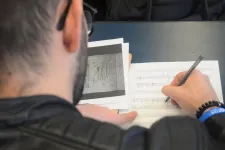(Press-News.org) UNIVERSITY PARK, Pa. -- In 1916 and 1917, a musician and book dealer named Giovanni Concina sold three ornately decorated seventeenth-century songbooks to a library in Venice, Italy. Now, more than 100 years later, a musicologist at Penn State has discovered that the manuscripts are fakes, meticulously crafted to appear old but actually fabricated just prior to their sale to the library. The manuscripts are rare among music forgeries in that the songs are authentic, but the books are counterfeit.
Uncovering deception was not what Marica Tacconi, professor of musicology and associate director of the School of Music at Penn State, set out to do when she began her research at the Biblioteca Nazionale Marciana of Venice in 2018. While on sabbatical there, she had planned to spend the fall semester studying 'echo effects' in seventeenth-century music -- phrases that are sung by the primary vocalist and then repeated 'in echo' by one or more additional singers.
While searching the library's database for songs incorporating echo effects, Tacconi stumbled upon a peculiar book. Catalogued as being from the seventeenth century, it certainly looked the part. It was bound in worn leather and embellished with brass bosses, or metal knobs that serve to elevate and protect the book from the table surface. Inside, the paper showed some signs of deterioration, including even an occasional worm hole. The first page revealed an elaborate letter 'T,' indicating the opening of the song "Tu mancavi a tormentarmi" by Antonio Cesti. The music itself was written with heart-shaped noteheads, and the bottom of the page displayed the coat of arms of the Contarini family, one of the most prominent and influential Venetian households.
"It was a beautiful, elegantly produced book," said Tacconi. "I was immediately intrigued. But I also sensed that something was off."
Additional research led to the discovery of two more manuscripts, also sold by Concina and very similar in format, design and content. Considered as a set, the three books preserve 61 compositions by 26 Italian composers, all written during the period from 1600 to 1678. According to Tacconi, an expert on the music, art and culture of early modern Italy, typical seventeenth-century music anthologies focus on just one or a few composers.
"The books comprised a strange conglomeration of composers, from very famous ones, like Giulio Caccini, Claudio Monteverdi and Francesco Cavalli, to lesser-known names. This was unusual for the seventeenth century when music anthologies tended to be more monographic in content," she said. "In addition, seventeenth-century scribes would not have had access to such a wide range of music, as many of those pieces had not yet been printed and existed only in manuscripts that did not circulate widely."
Despite her suspicions about the authenticity of the manuscripts, Tacconi was excited about the music itself.
"The manuscripts include arias that were foundational in the history of opera -- a genre that emerged in the early seventeenth century," she said. "They include musical gems that can tell us a lot about the origins and development of opera."
Upon further close investigation, she realized that much of the music in the manuscripts had been lifted, note for note, from a number of late nineteenth-/early twentieth-century books about music.
"The music copied in the manuscripts showed some strange editorial quirks that you can see in early twentieth-century editions, but that would not have appeared in seventeenth-century sources," said Tacconi, who proceeded to conduct a detailed comparison of the manuscripts with more modern books.
This type of painstaking comparison proved to be particularly fruitful in proving the manuscripts' fabricated nature. Tacconi's knowledge of a little-known twentieth-century book in particular, Hugo Riemann's "Handbuch der Musikgeschichte" (1912), provided verification of her suspicions. For example, one of the fabricated manuscripts included the song "Torna o torna pargoletto" by Jacopo Peri, which originally appeared in Piero Benedetti's "Musiche" -- a collection of songs published in 1611. Riemann included it in his "Handbuch," but with some alterations. Tacconi noticed these small but significant variants -- a wrong note, a misspelling of a word.
"It was obvious that the fabricator copied the music from Riemann's 1912 publication and not from the 1611 print," she said. "This was the 'smoking gun,' the confirmation that these books were indeed forgeries."
Tacconi noted that the books are unique among music forgeries in that most forgeries falsify the music itself.
"While the music preserved in these books is authentic, the manuscripts themselves are the handiwork of one or more fabricators who, working with several scribes and decorators, went through extraordinary means to make the volumes appear genuine," she said. "The books were clearly designed to look like those created for important Venetian households during the seventeenth century. It's not surprising that the library staff did not recognize them as fakes. At first glance they seem authentic, but once we look closely at the music and notice the editorial quirks, we detect the subtle traces of a twentieth-century fabricator."
Tacconi said that it is impossible to know whether Concina, who died in 1946, was the mastermind behind the forgeries or if he came into possession of the books with no knowledge of their fabricated nature.
Regardless of who generated the forgeries, an important question is "Why did they do it?"
"Monetary gain was probably not the main impetus," said Tacconi, explaining that the library paid Concina the equivalent of about $220 in today's money for one of the manuscripts. "That's a relatively modest sum, which does not really justify all the time and effort that went into producing these books. Instead, what we have is possibly an example of the fabricators engaging in a desire to hoodwink the experts."
In addition, she said, the forgers could have been motivated by a love for the music and the time period. "Imitation is the sincerest form of flattery," after all.
"Twentieth-century musicians and publishers often romanticized the music of the seventeenth century as being particularly elegant, and that elegance is something you see very clearly in the visual aspects of the three manuscripts," said Tacconi. "They're beautiful and ornate; their decorations include butterflies, birds and little cupids; the notes are heart shaped. The fact that the forgers went to such an effort to portray this elegance tells us something about the forgers' attitudes about the music of this time period. Knowing now that these books were created in the early twentieth century, the manuscripts and their contents actually provide an opportunity to study the late-Romantic tradition of so-called 'arie antiche' or 'gemme antiche,' which saw music collectors, musicians and audiences alike drawn to the antiquity of Italian Baroque solo vocal music."
INFORMATION:
Tacconi's findings appear in the Spring 2021 issue of the peer-reviewed Journal of Seventeenth-Century Music, which displays full-color images of the manuscripts (https://sscm-jscm.org/jscm-issues/volume-27-no-1/three-forged-seventeenth-century-venetian-songbooks/). .
A new study carried out in pig cells suggests previous infection with swine influenza virus (SIV) can protect against the development of porcine respiratory coronavirus (PRCoV) if there is a zero- or three-day interval between infections.
The findings, published in the peer-reviewed journal Virulence, may also be relevant to influenza and coronavirus infection in humans.
Ju-Yi Peng of the University of Veterinary Medicine Hannover and colleagues used air liquid interface cultures of cells taken from pigs' windpipes to investigate the interactions between the two viruses.
They found that prior infection by swine influenza virus completely inhibited coronavirus infection when the cells were infected ...
Berkeley -- Global land-use changes -- including forest fragmentation, agricultural expansion and concentrated livestock production -- are creating "hot spots" favorable for bats that carry coronaviruses and where conditions are ripe for the diseases to jump from bats to humans, finds an analysis published this week by researchers at the University of California, Berkeley, the Politecnico di Milano (Polytechnic University of Milan) and Massey University of New Zealand.
While the exact origins of the SARS-CoV-2 virus remain unclear, scientists believe that the disease likely emerged when a virus that infects horseshoe bats was able to jump to humans, either ...
Non-alcoholic fatty liver disease (NAFLD) is the most common cause of chronic liver disease worldwide. NAFLD patients are at higher risk of developing Non-alcoholic steatohepatitis (NASH), which causes severe and chronic liver inflammation, fibrosis and liver damage. A patient with NASH is believed to be at high risk for developing a form of liver cancer called hepatocellular carcinoma (HCC).
Apart from lifestyle interventions, there are currently no approved treatments for NASH. A liver transplant is sometimes the only remedy.
While risk factors for NASH (obesity, type-2 diabetes and gene mutations like PNPLA3) and HCC ...
CHAPEL HILL, North Carolina--Researchers have discovered a gene, OTUD7A, that impacts the development of Ewing sarcoma, a bone cancer that occurs mainly in children. They have also identified a compound that shows potential to block OTUD7A protein activity. The finding, by scientists at the University of North Carolina and the Lineberger Comprehensive Cancer Center, appeared online June 1, 2021, in Advanced Science.
About 250 children and young adults are diagnosed with Ewing sarcoma each year in the U.S. About half of those diagnosed will ultimately succumb to the disease, pointing to the need for better therapies.
"Our primary research focus targeted the EWS-FLI1 fusion protein found in about 85 percent of Ewing sarcoma patients," said UNC Lineberger's ...
"SWOG always brings an impressive portfolio of work to the ASCO annual meeting," said SWOG Chair Charles D. Blanke, MD, "and this year I'm particularly excited about the research our investigators are presenting because it includes results that are likely to be practice-changing."
Investigators will present 12 abstracts from SWOG-led or co-led studies and 11 abstracts from studies led by other groups within the National Clinical Trials Network (NCTN).
Results from S1216 will be presented orally by study chair Neeraj Agarwal, MD, of the Huntsman Cancer Institute at the University of Utah. S1216 compared androgen deprivation therapy (ADT) combined with TAK-700 to the standard ...
Quantum computing and quantum sensing have the potential to be vastly more powerful than their classical counterparts. Not only could a fully realized quantum computer take just seconds to solve equations that would take a classical computer thousands of years, but it could have incalculable impacts on areas ranging from biomedical imaging to autonomous driving.
However, the technology isn't quite there yet.
In fact, despite widespread theories about the far-reaching impact of quantum technologies, very few researchers have been able to demonstrate, using the technology available now, that quantum methods have an advantage over their classical counterparts.
In a paper published on June 1 in the journal Physical Review X, University of Arizona researchers experimentally ...
Irvine, CA - June 1, 2021 - A new study analyzing the association between an individual's genetics (genotype) and their observable characteristics resulting from the interaction of genetics and the environment (phenotype), contributes new knowledge to the understanding of human complex traits and diseases.
The study titled, "An atlas of alternative polyadenylation quantitative trait loci (3?aQTLs) contributing to complex trait and disease heritability," was recently published in Nature Genetics. Led by University of California, Irvine professor of ...
Over 50% of adults surveyed across six different countries report experiencing weight stigma, and those who engage in self-stigma and self-blame for their weight are more likely to avoid healthcare, obtain less frequent checkups, and perceive less respect from doctors, according to two new studies from the UConn Rudd Center for Food Policy and Obesity. These studies, which compared experiences of adults in Australia, Canada, France, Germany, the UK, and the US are the first multi-national studies to examine the link between weight stigma and negative ...
Plasmodium vivax malaria is a mosquito-borne illness that causes significant morbidity. However, the household and healthcare provider costs of the disease are unknown. A new study published in the open-access journal PLOS Medicine by Dr Angela Devine at Menzies School of Health Research in Australia, and colleagues estimate the global economic burden of P. vivax for the first time using country-level data.
Researchers first estimated household and healthcare provider P. vivax costs, then collated and combined these data with national case estimates for 44 endemic countries in 2017. The resulting global cost estimate was US$359 million.
The authors wanted to explore how these cost estimates might change with widespread access to radical cure. Radical ...
Observational studies have suggested that increased vitamin D levels may protect against COVID-19. However, these studies were inconclusive and possibly subject to confounding. A study published in PLOS Medicine by Guillaume Butler-Laporte and Tomoko Nakanishi at McGill University in Quebec, Canada, and colleagues suggests that genetic evidence does not support vitamin D as a protective measure against COVID-19.
The ability of vitamin D to protect against severe COVID-19 illness is of great interest to public health experts, but has limited supporting evidence. To assess the relationship between vitamin D levels and COVID-19 susceptibility ...




